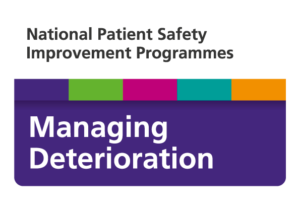Managing Deterioration
 About the programme
About the programme
The aim of the Managing Deterioration programme is to reduce deterioration associated harm by improving the planning, identification, escalation and response (PIER) to physical deterioration through better system co-ordination and as part of safe and reliable pathways across health and social care by March 2023.
- Support testing of the national Paediatric Early Warning System (nPEWS) across a cohort of hospitals to be completed by the end of September 2022 or sooner, based on a review of progress at the end of June 2022.
- Adoption of deterioration management tools (RESTORE2/RESTORE 2 Mini or equivalent) in at least 85% of care homes (including those homes caring for people with Learning Disability and Autism and Mental Health) by the end of March 2023.
Who we are working with
We are working across a range of acute and community settings in health and social care to achieve our aim. In order to improve the identification of deterioration in children, we are working with paediatric colleagues to test implementation of the Paediatric Early Warning Score (PEWS) across different sites in the region. As part of our work in managing deterioration in non-acute settings, we provide training to spread knowledge of deterioration management tools e.g. RESTORE2mini, SBARD and softer signs tools.
Main deliverables
There are four key programme deliverables:
- Training in the use and application of RESTORE2/RESTORE2 mini or equivalent tools delivered to 95% of care homes by the end of March 2023
- Adoption of RESTORE2/RESTORE2 mini or equivalent tools within an embedded care home PIER pathway in 85% of care homes by the end of March 2023
- Sustainable adoption of RESTORE2/RESTORE2 mini or equivalent tools (identified reliable application for at least 1 year) in 40% of care homes by the end of March 2023
- Development and delivery of local data sets that ensure regular reporting and review of resident related outcomes to improved acute physical deterioration monitoring.
PSCs will be required to:
- work with their local AHSN measurement/analytical resource, ICSs and other key stakeholders to capture, report and apply learning from relevant measures of outcome at ICS or appropriate system level, in collaboration with nationally procured measurement function.
- work with a small number of care homes directly to count/measure the impacts of adoption of RESTORE2/RESTORE2 mini or equivalent tools within appropriate escalation and response pathways on resident outcomes.
Note: scope includes care homes as defined by the Care Quality Commission (CQC) only – excluding domiciliary care, supported living etc. This includes all care homes registered by the CQC, irrespective of NHS funding. Unregistered care homes are excluded
How to get involved
Please contact Elizabeth Sweeting – Deterioration SIP Work stream lead/ Clinical leadership fellow
